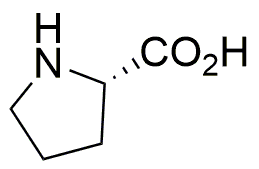L-Proline, from non-animal source, suitable for cell culture is widely utilized in research focused on:
- Cell Culture Media: This compound serves as a vital amino acid in cell culture, promoting cell growth and viability, particularly in mammalian cell lines.
- Biotechnology: It is used in the production of biopharmaceuticals, enhancing protein stability and solubility, which is crucial for therapeutic protein formulations.
- Food Industry: As a flavor enhancer and stabilizer, it improves the texture and taste of various food products, making it valuable for food scientists.
- Cosmetics: L-Proline is incorporated into skincare formulations for its moisturizing properties, helping to improve skin hydration and elasticity.
- Research Applications: It is frequently utilized in studies related to metabolic pathways and protein synthesis, offering insights into cellular functions and disease mechanisms.
General Information
Properties
Safety and Regulations
Applications
L-Proline, from non-animal source, suitable for cell culture is widely utilized in research focused on:
- Cell Culture Media: This compound serves as a vital amino acid in cell culture, promoting cell growth and viability, particularly in mammalian cell lines.
- Biotechnology: It is used in the production of biopharmaceuticals, enhancing protein stability and solubility, which is crucial for therapeutic protein formulations.
- Food Industry: As a flavor enhancer and stabilizer, it improves the texture and taste of various food products, making it valuable for food scientists.
- Cosmetics: L-Proline is incorporated into skincare formulations for its moisturizing properties, helping to improve skin hydration and elasticity.
- Research Applications: It is frequently utilized in studies related to metabolic pathways and protein synthesis, offering insights into cellular functions and disease mechanisms.
Documents
Safety Data Sheets (SDS)
The SDS provides comprehensive safety information on handling, storage, and disposal of the product.
Product Specification (PS)
The PS provides a comprehensive breakdown of the product’s properties, including chemical composition, physical state, purity, and storage requirements. It also details acceptable quality ranges and the product's intended applications.
Certificates of Analysis (COA)
Search for Certificates of Analysis (COA) by entering the products Lot Number. Lot and Batch Numbers can be found on a product’s label following the words ‘Lot’ or ‘Batch’.
*Catalog Number
*Lot Number
Certificates Of Origin (COO)
This COO confirms the country where the product was manufactured, and also details the materials and components used in it and whether it is derived from natural, synthetic, or other specific sources. This certificate may be required for customs, trade, and regulatory compliance.
*Catalog Number
*Lot Number
Safety Data Sheets (SDS)
The SDS provides comprehensive safety information on handling, storage, and disposal of the product.
DownloadProduct Specification (PS)
The PS provides a comprehensive breakdown of the product’s properties, including chemical composition, physical state, purity, and storage requirements. It also details acceptable quality ranges and the product's intended applications.
DownloadCertificates of Analysis (COA)
Search for Certificates of Analysis (COA) by entering the products Lot Number. Lot and Batch Numbers can be found on a product’s label following the words ‘Lot’ or ‘Batch’.
*Catalog Number
*Lot Number
Certificates Of Origin (COO)
This COO confirms the country where the product was manufactured, and also details the materials and components used in it and whether it is derived from natural, synthetic, or other specific sources. This certificate may be required for customs, trade, and regulatory compliance.


